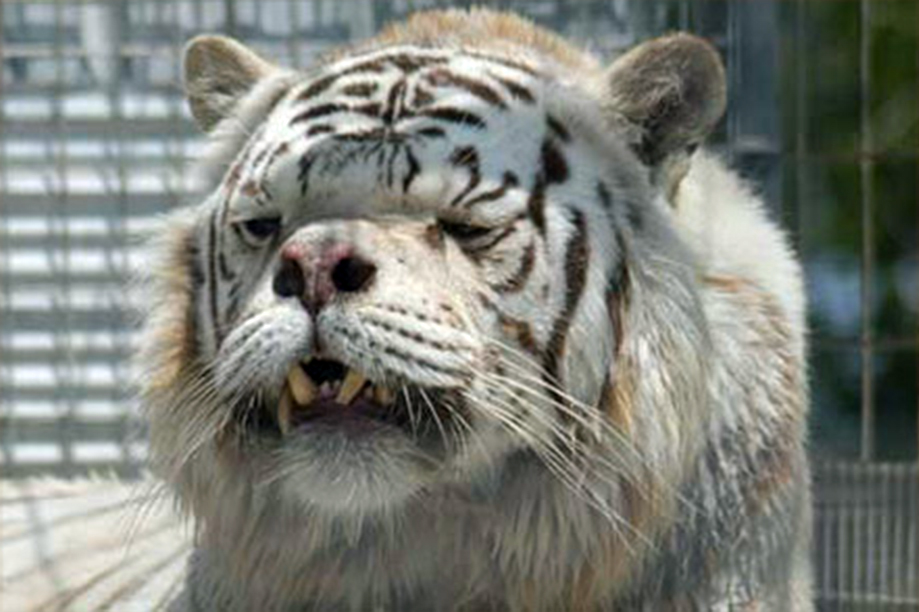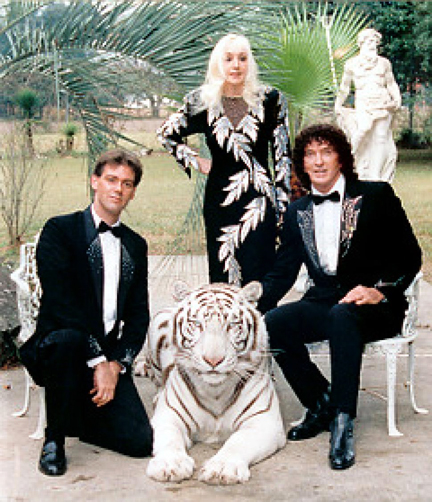The White Tiger Myth
There is no such species as the Royal White Bengal Tiger. The name was invented in 1980 to attract people to a nightclub act in Las Vegas. There are no white tigers in the wild; all the whites in this country are the product of 60 years of inbreeding. Because of the inbreeding, over 50% of white tigers die as cubs, and those who survive suffer from physical defects. Tigers in America has rescued or relocated 12 white tigers to true sanctuaries. Contact us directly and we will tell you where they are.
History
In 1951 a white tiger cub was captured in India after his mother and three orange siblings were killed. He was given to the Maharajah of Rewa who named him Mohan and began a breeding program to create more white tigers. In 1958 Mohan was bred to one of his daughters and the first litter of white tigers was born in captivity. Mohini, a product of subsequent breeding, was bought by an American businessman from the Maharajah and given to the National Zoo in Washington D.C.
After a visit with President Eisenhower and a well-publicized country-wide tour, Mohini became a celebrity. The Cincinnati Zoo acquired her and began their own white tiger breeding program. In 1983 Siegfried and Roy purchased 3 white cubs from the zoo, including the first pure white (without stripes) cub, for their Las Vegas act. White tigers became their signature animal and established the market value for white tiger cubs with black stripes at $30,000 and pure white tigers (no stripes) at $100,000. Siegfried and Roy became the highest grossing act in the history of Las Vegas, performing for 25 years to sold-out audiences. This led generations of Americans to believe that a tiger is no longer a wild animal but a performing pet.
White tigers are highly sought after by exhibitors who often ask for contributions to “conserve” their species. White tiger popularity gave birth to a breeding binge that emerged from the zoo system into the backyards of animal breeders who constantly tried to breed more white tigers. The white coat is caused by a double recessive gene that occurs in perhaps one out of 10,000 tigers in the wild. In captivity the tiger parents are inbred and only produce one white cub for every 30 born. Cub mortality for white cubs is in excess of 50%, and those who survive suffer from some level of birth defects from crossed eyes to cleft palates to spinal deformities to club feet.
All white tigers have crossed eyes, whether it shows or not, because the gene that causes the white coat always causes the optic nerve to be wired to the wrong side of the brain. That is another reason white tigers are such a favorite in tiger acts. They are more dependent on their masters because they can’t see clearly and their reaction time is diminished. Only 1 in 10 of the white cats can perform consistently and those that do are unpredictable because of their genetic impairments.

So the next time you see a white tiger that is not in a sanctuary, keep in mind there were 299 tigers that didn’t pass the audition and will go back into the breeding system—and if unable to breed, will be dumped at a roadside zoo.
Cat Dancers

In 1998 Chuck and Joy, two of the three performers in a tiger act called “Cat Dancers”, were killed by their white tiger Jupiter (bred by Betty Young in Arkansas). Local police shot Jupiter after he killed Joy. TIA participated in the shutdown of Betty Young.
Siegfried and Roy
In 2003 Roy almost died after Mantacore, one of his white tigers, mauled him during a performance, ending Siegfried and Roy’s long run in Las Vegas. Roy died in 2020 and Siegfried died in 2021.
TIA was instrumental in relocating their last 11 cats, including four white tigers and two white lions, from the Secret Garden at the Mirage hotel to two TIA named sanctuaries.

White tiger video access available upon request.